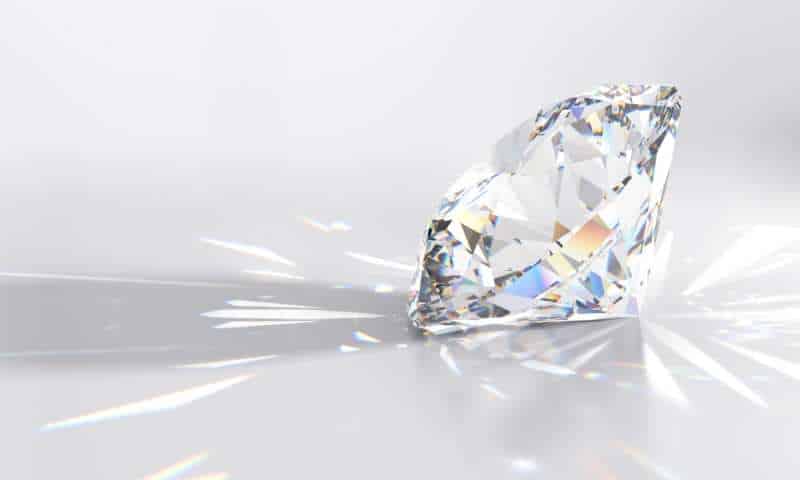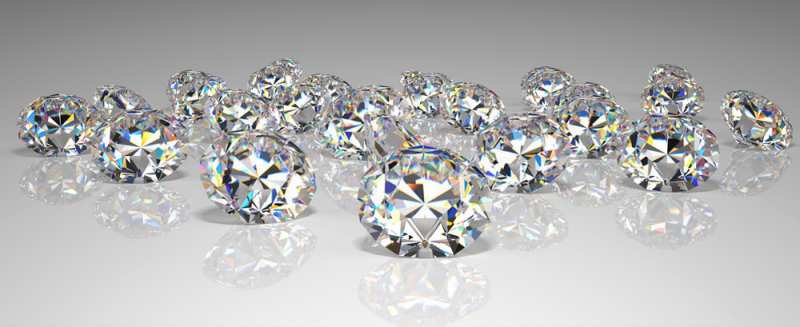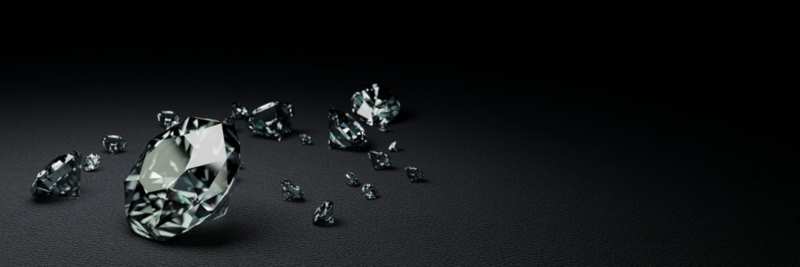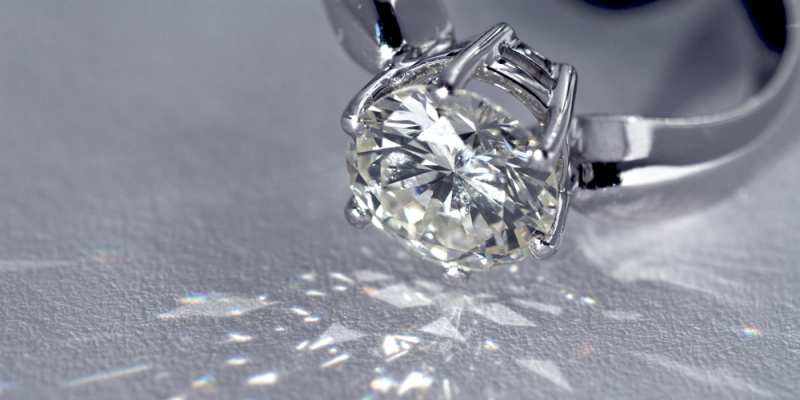Regardless of the opulence of your jewelry collection, there is nothing that can compare to the mesmerizing allure of a diamond. These exquisite gems always take the spotlight!
Diamonds possess an irresistible charm, commanding high prices and immense desire. However, what truly sets them apart is their captivating sparkle. Now, the question arises: What is the secret behind a diamond’s dazzling brilliance?
While the innate radiance of a diamond contributes to its sparkle, it is important to note that expert cutting and polishing play a significant role as well. Prepare yourself for a comprehensive explanation of this captivating phenomenon!
DESIGN YOUR OWN ENGAGEMENT RING: START WITH A SETTING OR START WITH A DIAMOND. IT’S REALLY UP TO YOU!

Why Diamonds Sparkle? Where Does Their Sparkle Come From?
Brilliance
The first question we shall explore is the source of a diamond’s brilliance. When you encounter diamonds at a jewelry store, their brilliance can be attributed to several factors, with the following three being the most significant:
- Reflection
Reflection refers to the light that strikes the surface of the diamond and reflects back, creating an immediate shine. While this effect is visually stunning, it represents only a fraction of the true radiance of a genuine diamond.
In reality, a substantial portion of the light penetrates through the diamond rather than bouncing back.
See Also: Do Diamonds Emit Light?
- Refraction
Refraction is responsible for the mesmerizing sparkle that diamonds are renowned for. It occurs when light traversing through the diamond is refracted and dispersed.
- Dispersion
Dispersion is the phenomenon that produces a rainbow effect when light enters a diamond. The intricate structure of diamonds acts as a prism, causing the light to hit various angles before exiting the surface.
Dispersion greatly contributes to the shine and allure of these precious stones.
Refraction and dispersion collaborate to create areas of both light and darkness within the diamond, depending on the direction of the incoming light.
The dark areas do not diminish the brilliance; instead, they enhance it. In fact, without these dark spots, the diamond would lack the magical effect and its trademark brilliance.
The contrast between light and dark intensifies the brilliance, akin to how a candle shines more brightly in a dark room. This interplay of light and shadow ensures the remarkable shine and distinctive fire of diamonds.
Fire
When white light enters a diamond, it bends and separates into a spectrum of colors, resulting in what we call fire. This is the same phenomenon that forms rainbows when light passes through water droplets.
The amount of fire exhibited by a diamond depends on its cut. Certain diamond cuts display more fire than others. For instance, emerald-cut diamonds possess a considerable amount of fire but may have less brilliance compared to brilliant-cut diamonds. This is an essential consideration when selecting a diamond.
Scintillation
Scintillation is the effect produced by the movement of light within a diamond. It manifests as a captivating interplay of white and colored flashes when observing the diamond in motion. Some might say that scintillation breathes life into the diamond.
There are two types of scintillation:
- Flash scintillation: This occurs when bright flashes of light dance across the polished facets of the gem.
- Fire scintillation: This refers to flashes of color observed within the diamond.
The quality of a diamond’s polish significantly impacts its scintillation. Brilliance, fire, and scintillation must work harmoniously to achieve the mesmerizing “across-the-room sparkle” associated with diamonds.
However, it is important to note that only a select few diamonds in the world possess this extraordinary overall effect, and they are truly breathtaking.

What Are The Other Factors That Make The Diamond Sparkle?
The Cut And Shape Of A Diamond
The brilliance of a diamond is significantly influenced by its cut and shape. It’s crucial for the diamond to have a proper balance—not too deep or too shallow.
If the diamond cutter makes an error, the light entering the diamond won’t bounce back as effectively. It may either get lost or escape through the bottom, diminishing its shimmering impression.
Perfecting diamond cuts was no easy task. However, thanks to the relentless pursuit of enhanced brilliance, the most popular diamond shapes available today offer exceptional light performance. These designs combine natural properties with intricate angles to deliver both maximum sparkle and aesthetic appeal.
You now have the privilege of enjoying diamonds that exhibit the utmost brilliance and come in the most visually pleasing shapes.
Symmetry
To ensure a diamond reaches its full potential and shines as brilliantly as possible, the diamond cutter must pay careful attention to its symmetry. Symmetry demands equal proportions on all sides and precise cutting of all facets.
Even slight deviations from perfect symmetry hinder proper light refraction, compromising the overall brilliance.
Clarity
Clarity also impacts the diamond’s brilliance, albeit to a lesser extent. Surface imperfections limit the amount of light that enters the diamond. Inclusions, on the other hand, obstruct the free movement of light within the diamond.
Therefore, a gemstone with fewer imperfections will exhibit greater brilliance.
Polishing
Once the diamond cutter achieves or strives for perfection in the cut and shape, ensuring the diamond adequately reflects light, the gem receives its finishing touches—polishing.
The final step in achieving scintillating shine is to polish the diamond’s surface. Polishing not only removes residual roughness or external blemishes but also enhances the gem’s brilliance. A well-executed polish brings out the diamond’s allure, making it even more captivating.
As evident, achieving the perfect sparkle and shine for a diamond is no simple task, even for seasoned professionals. Each stone is unique, yet the desired outcome remains the same: brilliance!
So, the next time you visit a jewelry store, remember the tremendous effort that went into creating the beautiful diamonds displayed before you. Each diamond you see, radiating a magnificent display of light and color as you move it, is a small work of art.
The scintillation and dazzling array of light and colors are what make diamonds as valuable as they are. We will delve into their value in the following section.

Does Diamond Brilliance Have Any Influence On Its Value?
Indeed, the effects of scintillation and fire are what make diamonds alluring and highly valuable. Without these captivating properties, gems would not hold the same level of allure and prestige.
Consequently, the diamond cutting process plays a pivotal role in determining the ultimate price of a diamond. It is through this process that the gem is transformed from an unattractive crystal in the earth to a luxurious and exquisite piece of jewelry.
As evident, the expertise of the diamond cutter is of utmost importance. Only a seasoned and skilled professional can unveil the hidden beauty within a gem. By carefully shaping and faceting the rough crystal, the diamond cutter alters the way light interacts with the diamond, enhancing its brilliance.
The cut and proportions of a diamond significantly impact its value. In fact, they can account for up to 40 percent of the final price. This highlights the substantial influence of the diamond’s cut on its overall worth.
Given these factors, diamond cutting is a meticulous skill that demands extensive expertise, time, and effort. It is through the mastery of this craft that diamonds attain their unparalleled beauty and desirability.

What Are Other Criteria That Influence The Value Of A Diamond?
The price of a diamond is determined by the four Cs, which are as follows:
- Carat: Carat refers to the weight of the diamond. One carat is equivalent to 0.2 grams or 100 points. To ensure precision, diamonds are weighed using highly accurate scales that can measure up to 0.000001 grams.
- Clarity: Most diamonds contain impurities and inclusions, which are traces of other materials that became trapped within the diamond during its formation. Diamond cutters strive to minimize these imperfections through processes like splitting, sawing, grinding, and polishing. The fewer impurities a diamond has, the higher its value.
- Cut: We have already discussed how the quality of a diamond’s cut influences the way light interacts with the gem, ultimately affecting its sparkle. Diamond cutters employ precise mathematical formulas to shape each stone, ensuring that every facet is positioned at an optimal angle. Different cutting formulas exist, with one of the most well-known being the round brilliant cut developed by Marcel Tolkowsky, a renowned Belgian mathematician, in 1919.
- Color: The majority of diamonds are colorless, ranging from completely colorless to slightly yellowish. However, a small percentage of diamonds exhibit distinct colors such as red, yellow, pink, green, brown, or black. These colored diamonds, known as “fancy” diamonds, are highly sought after. Among them, blue and pink diamonds are particularly rare and valuable.
These four factors—carat, clarity, cut, and color—play crucial roles in determining the value of a diamond. By considering these attributes, buyers can make informed decisions when selecting a diamond that aligns with their preferences and budget.

How To Preserve The Sparkle Of Your Diamond?
Over time, diamonds can accumulate dirt and grease, causing them to lose some of their sparkle. This is especially true for diamond rings that come into contact with hand creams and oils. It is essential to regularly clean your diamond jewelry to maintain its brilliance. So, how can you clean your diamond jewelry at home?
The easiest method for cleaning your diamond jewelry at home is by soaking it in a gentle degreasing solution. You can either purchase a specially formulated cleaning solution or make one yourself. To create your own solution, simply mix lukewarm water with a few drops of mild dish soap.
Allow your diamond jewelry to soak in the cleaning solution for at least ten minutes. After soaking, use a soft and clean toothbrush to gently scrub away any remaining impurities.
By following this cleaning process, you can keep your diamond jewelry sparkling and beautiful for many years to come.

Conclusion
Diamonds possess their mesmerizing sparkle due to various factors, with the way light interacts with them being paramount. A diamond that is well-cut and perfectly proportioned reflects the majority of light, which then radiates back to the observer through the table facet. This phenomenon is known as brilliance.
Symmetry plays a crucial role in a diamond’s sparkle as well. If a diamond lacks proper symmetry, it will allow light to escape, resulting in diminished brilliance.
Beyond brilliance, a diamond’s allure is further enhanced by scintillation and fire, which bring the gemstone to life. The clarity of a diamond, along with the expertise in cutting and polishing it to perfection, significantly influences its beauty and value.
While there are objective factors at play, the perception of beauty is subjective, and your personal preference holds great importance when selecting a diamond for yourself or someone dear to you.


